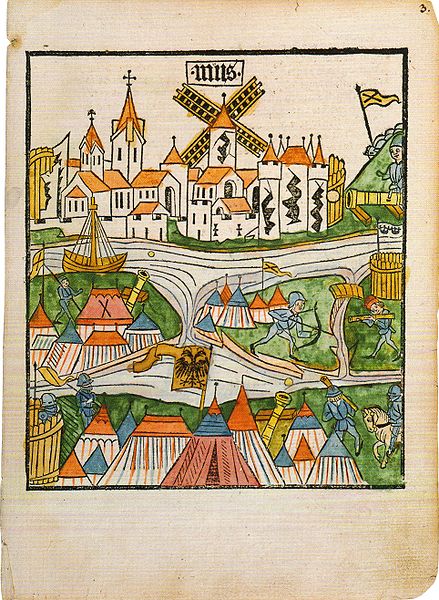-
500th Anniversary of the unsuccessful siege of Neuss by Duke Charles the Bold of Burgundy
Germany 1975.05.15
In issue: Stamp(s): 1
-
Number by catalogue: Michel: 843 Yvert: 692 Scott: 1169
Perforation type: 14x14
Subject:
50 pfennings. On the stamp the reproduction of an engraving of 1477 where the battle stage of The Siege of Neuss** by Charles the Boldeor* is represented
Additional:
*Charles the Boldor Charles the Rash (French: Charles le Téméraire) (10 November 1433 – 5 January 1477), baptised Charles Martin, was Duke of Burgundy from 1467 to 1477.
Known as Charles the Terrible to his enemies, he was the last Valois Duke of Burgundy and his early death was a pivotal, if under-recognised, moment in European history.
made a Knight of the Golden Fleece just twenty days after his birth, being invested by Charles I, Count of Nevers and the seigneur de Croÿ.
He was brought up under the direction of the Seigneur d'Auxy, and early showed great application to study and also to warlike exercises. His father's court was the most extravagant in Europe at the time, and a centre for arts and commerce. While he was growing up, Charles witnessed his father's efforts to unite his increasing dominions in a single state, and his own later efforts centered on continuing and securing his father's successes.
Making a last effort, Charles formed a new army and arrived in the depth of winter before the walls of Nancy. Having lost many of his troops through the severe cold, it was with only a few thousand men that he met the joint forces of the Lorrainers and the Swiss, who had come to the relief of the town, at the Battle of Nancy (5 January 1477). He himself perished in the fight, his naked body being discovered some days afterwards, the face so mutilated by wild animals that only his physician was able to identify him by old scars on his body.
**The Siege of Neuss,from 1474–1475, was part of the Burgundian Wars. The siege, led by Charles the Bold against the Holy Roman Empire city of Neuss, was unsuccessful. Charles had been compelled by the approach of a powerful imperial army to raise the siege.
The failure of the siege of Neuss was attributed by the inhabitants of the city to the intervention of their patron saint, Quirinus of Neuss.
The engraving is ofrom the Sotheby's. Incunabula from the Court Library at Donaueschingen


1975-s-logo.jpg)